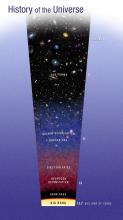Listen to today's episode of StarDate on the web the same day it airs in high-quality streaming audio without any extra ads or announcements. Choose a $8 one-month pass, or listen every day for a year for just $30.
You are here
Seeing Deep
By the time the universe was a billion years old, something had given it a real charge. That “something” could be the first galaxies. And thanks to some help from cosmic magnifying glasses, astronomers have seen enough early galaxies to make that possibility more likely.
A few hundred thousand years after the Big Bang, electrons and protons began sticking together to make atoms of hydrogen. The atoms had no electric charge. By a billion years later, though, most of the hydrogen atoms had been split apart, giving them a charge. Learning what caused this can help astronomers better understand the early universe.
In a project known as the Hubble Frontier Fields, Hubble Space Telescope stared at several galaxy clusters for weeks at a time. The gravity of the immense mass in such a cluster acts as a magnifying lens, so it makes the galaxies that appear beyond the cluster look brighter. That revealed galaxies that were just one percent as bright as the galaxies that Hubble could see without it.
Astronomers at the University of Texas developed a way to remove the bright light from the cluster galaxies from the Hubble pictures. That allowed them to see the faint background galaxies — some of them up to 13 billion light-years away — among the first galaxies in the universe.
The images showed only a tiny fraction of the early universe. But they revealed enough distant galaxies to make it more likely that they gave the universe a charge.
Script by Damond Benningfield




